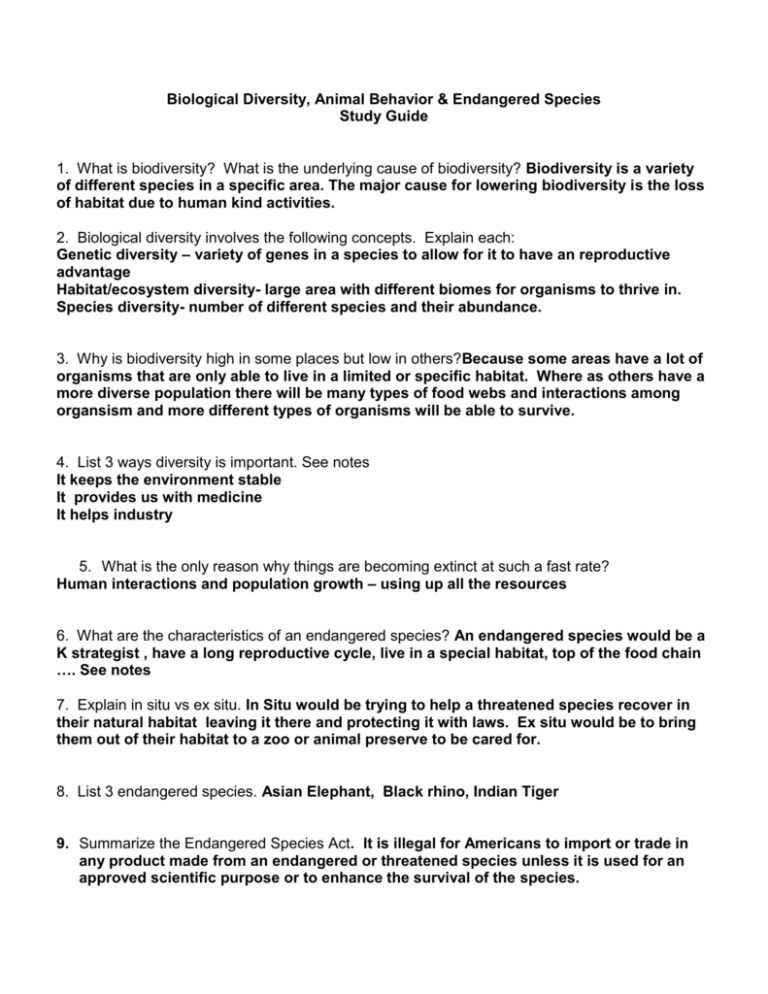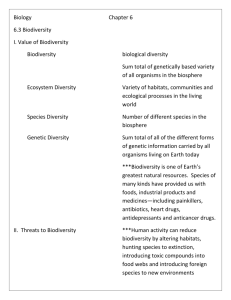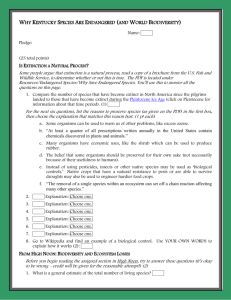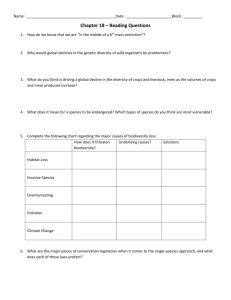Biological Diversity, Animal Behavior & Endangered
advertisement

Biological Diversity, Animal Behavior & Endangered Species Study Guide 1. What is biodiversity? What is the underlying cause of biodiversity? Biodiversity is a variety of different species in a specific area. The major cause for lowering biodiversity is the loss of habitat due to human kind activities. 2. Biological diversity involves the following concepts. Explain each: Genetic diversity – variety of genes in a species to allow for it to have an reproductive advantage Habitat/ecosystem diversity- large area with different biomes for organisms to thrive in. Species diversity- number of different species and their abundance. 3. Why is biodiversity high in some places but low in others?Because some areas have a lot of organisms that are only able to live in a limited or specific habitat. Where as others have a more diverse population there will be many types of food webs and interactions among organsism and more different types of organisms will be able to survive. 4. List 3 ways diversity is important. See notes It keeps the environment stable It provides us with medicine It helps industry 5. What is the only reason why things are becoming extinct at such a fast rate? Human interactions and population growth – using up all the resources 6. What are the characteristics of an endangered species? An endangered species would be a K strategist , have a long reproductive cycle, live in a special habitat, top of the food chain …. See notes 7. Explain in situ vs ex situ. In Situ would be trying to help a threatened species recover in their natural habitat leaving it there and protecting it with laws. Ex situ would be to bring them out of their habitat to a zoo or animal preserve to be cared for. 8. List 3 endangered species. Asian Elephant, Black rhino, Indian Tiger 9. Summarize the Endangered Species Act. It is illegal for Americans to import or trade in any product made from an endangered or threatened species unless it is used for an approved scientific purpose or to enhance the survival of the species. Authorizes the Marine Fishery Service and the U.S. Fish and Wildlife Service to identify and list all other endangered & threatened species. These species cannot be hunted, killed, collected or injured in the U.S. 10. How do scientists account for the development of life on earth? Using the fossil record, DNA & chemical analysis and ice cores. 11. What is biological evolution by natural selection, and how can it account for the current diversity of organisms on the earth? Biological evolution by natural selection involves the change in a population’s genetic makeup through successive generations. It can account for the current diversity due to genetic variability from offspring produced during meiosis, and Mutations: random changes in the structure or number of DNA molecules in a cell that can be inherited by offspring. The larger the gene pool the more stable the ecosystems biodiversity. 12. How can geologic processes, climate change and catastrophes affect biological evolution?It can wipe out existing species and create new ones through geographic isolation,reproductive isolation, and loss of gene pool. 13. What is an ecological niche, and how does it help a population adapt to changing the environmental conditions? The ecological niche describes how an organism or population responds to the distribution of resources and competitors (e.g., by growing when resources are abundant, and when predators, parasites and pathogens are scarce) and how it in turn alters those same factors (e.g., limited access to resources by other organisms, acting as a food source for predators and a consumer of prey 14. How do extinction of species and formation of new species affect biodiversity? It changes ecosystems by fragmenting food webs and chains, resources are removed and many organisms cannot adapt and die off. 15. What is the future of evolution, and what role should humans play in this future? The future of evolution is man created due to habitat loss, and resource uptake. We are begin forced to engineer organisms for the future. IF we do not recover the organisms for today they will be lost forever. 16. How did we become such a powerful species in a short time? Due to our large gene pool and genetic diversity. 17. How have human activities affected the earth’s biodiversity? Loss of habitat, pollution of air and water. How should forest resources be used, managed, and sustained globally and in the United States? Identify and protect forest areas high in biodiversity • Grow more timber on long rotations • Rely more on selective cutting and strip cutting • Stop clear-cutting on steep slopes • Cease logging of old-growth forests • Prohibit fragmentation of remaining large blocks of_forest • Sharply reduce road building into uncut forest areas • Leave most standing dead trees and fallen timber for wildlife habitat and nutrient recycling • Certify timber grown by sustainable methods • Include ecological services of forests in _estimating their economic value • Plant tree plantations on deforested and degraded land 18. How serious is tropical deforestation, and how can we help sustain tropical forests? At least half of the world’s terrestrial plant and animal species live in tropical rain forests. Large areas of tropical forest are burned to make way for cattle ranches and crops up to 7000 fires a day. They are shrinking at aiarming rates. 19. How should rangeland resources be used, managed, and sustained? Suppress growth of invasive species, rotational grazing, reduce soil erosion, replant barren areas, use less fertilizer and herbicides. 20. What problems do parks face, and how should we manage them? Too many visitors, private owners in parks, money needed to fix, loss of species, pollution – need to buy up private owners, charge more, and make parking lost off the site. 21. How should we establish, design, protect, and manage terrestrial nature reserves?By passing laws world wide for protection of biodiversity, including ecosystems, species and populations, promote the long-term survival of the species and other elements of biodiversity they contain by maintaining natural processes and viable populations and by excluding threats. To meet these objectives, conservation planning must deal not only with the location of reserves in relation to natural physical and biological patterns but also with reserve design, for example the watershed that they will rely on. 22. What is wilderness, and why is it important? Wilderness is defined by the Wilderness Act of 1964 as “. . . an area where the earth and its community of life are untrammeled by man, where man himself is a visitor who does not remain. An area of wilderness is further defined to mean in this Act an area of undeveloped Federal land retaining its primeval character and influence, without permanent improvements or human habitation, which is protected and managed so as to preserve its natural conditions and which (1) generally appears to have been affected primarily by the forces of nature, with the imprint of man's work substantially unnoticeable; (2) has outstanding opportunities for solitude or a primitive and unconfined type of recreation; (3) has at least five thousand acres of land or is of sufficient size as to make practicable its preservation and use in an unimpaired condition; and (4) may also contain ecological, geological, or other features of scientific, educational, scenic, or historical value” . Value – they provide natural resources, air, water 23. What is ecological restoration, and why is it important? Restoration: trying to return to a condition as similar as possible to original state. We need to fix the ecosystem to prevent its collapse. 24. What can we do to help sustain the earth’s terrestrial biodiversity?identify and protect those areas that are severely threatened and provide ecological services.Humans dominate most of the land so they will have to share it in order to maintain species diversity. Locate endangered species, develop new laws if needed to protect and restore degraded ecosystems. 25. How do biologists estimate extinction rates, and how do human activities affect these rates? It is difficult to measure we have to use the biodiversity methods of sampling and counting species and the Shannon weaver method All species become extinct Since humans arrived, rate of extinction has gone up 100 to 1,000 times and by some estimates 10,000 timesConservative extinction rates 0.01% - 1.0% 26. Why should we care about protecting wild species? New species eventually evolve to take the place of those lost through extinction spasms, mass depletions, or mass extinctions it will take at least 5 million years for natural speciation to rebuild the biodiversity we are likely to destroy during this century prevention the premature extinction of species because of their instrumental value 62% of all cancer drugs were created by bioprospecting discoveries, including the key ingredient in Taxol, which is used to treat breast canceranother instrumental value is the genetic information in species that allows them to adapt to changing environmental conditions and to form new species – this is useful to genetic engineers We can learn how nature works and sustain itself wildlife tourism, ecotourism, generates at least $500 billion per year worldwide, and perhaps twice as much 27. Which human activities endanger wildlife? All of them 28. How can we help prevent premature extinction of species?Reduce invasive species, pass laws and enforce them to protect species, reduce the effects of overpopulation and pollution, reduce climate change, prevent overexploitation of organisms illegal killing and selling of animals, exotic species not allowed to be imported. 29. What is reconciliation ecology, and how can it help prevent premature extinction of species? Reconciliation ecology involves finding ways to share the places we dominate with other species. Practicing reconciliation ecology begins by looking at the habitats we prefer and realize that is not what wildlife prefers








